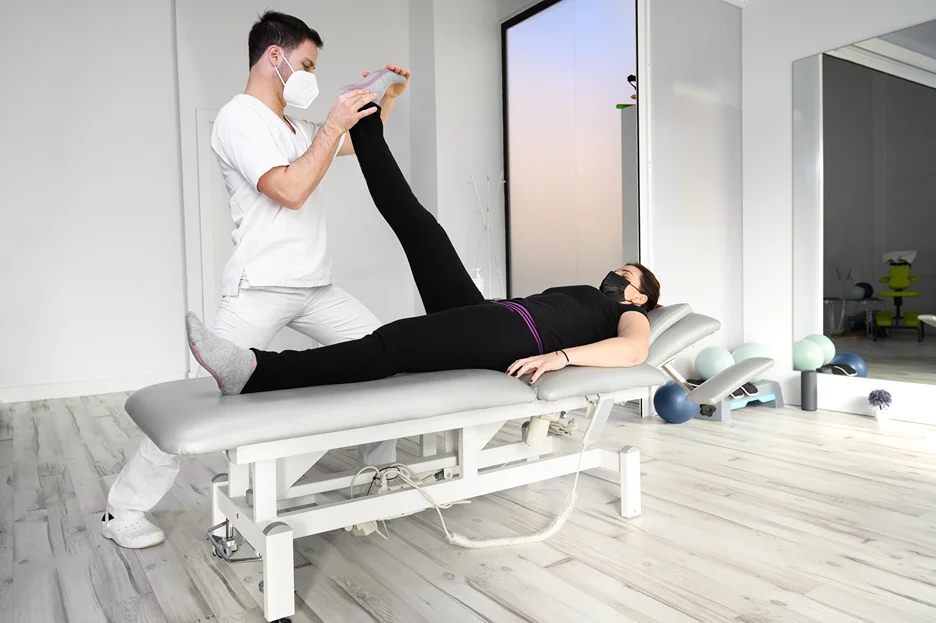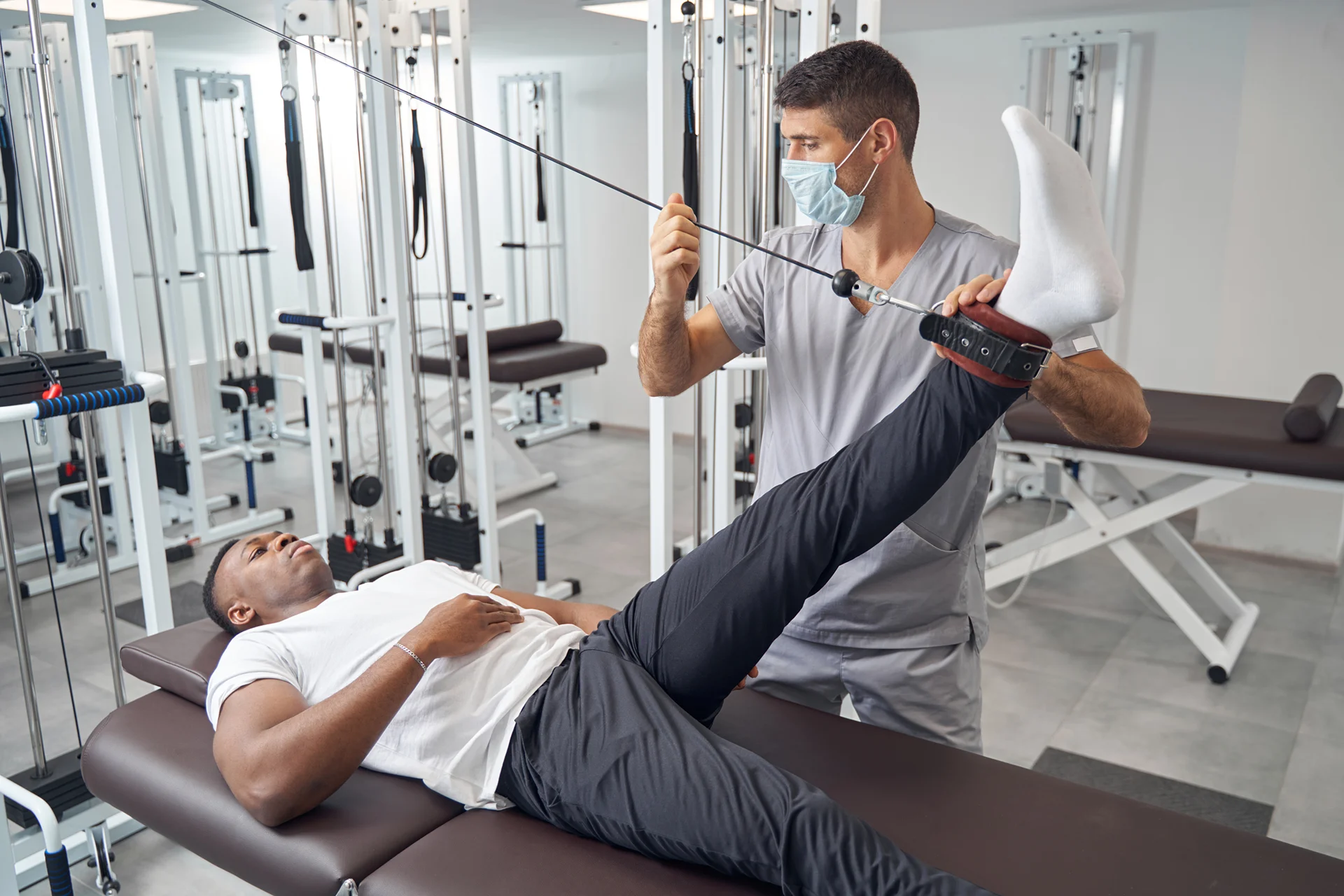Discover how this simple, low-risk exam can provide answers and set you on the path to sciatica relief.
You likely arrived at this article because you’re experiencing pain, tingling, or numbness radiating from your lower back down your leg.
This painful sensation is commonly caused by sciatica – irritation or compression of the sciatic nerve which runs from your lower back down each leg. Sciatica can result in debilitating pain that impacts your mobility and quality of life. That’s why getting an accurate diagnosis is crucial. It allows you to pursue the right treatment plan to find relief as quickly as possible.
Understanding the diagnostic process starts with learning about the straight leg raise (SLR) test – one of the most commonly used clinical tests for sciatica. At Kaly, we want to empower you with knowledge about how the SLR test is performed, what it means, and how it fits into the broader process of securing an accurate sciatica diagnosis.
Understanding the Straight Leg Raise (SLR) Test

What is the straight leg raise (SLR) test for sciatica?
The straight leg raise test is a simple diagnostic procedure used to determine whether your sciatic nerve is being irritated or compressed.
It involves lying on your back while your provider lifts your affected leg upwards using a steady, controlled motion. This places tension on the sciatic nerve, often reproducing the same pain symptoms you’ve been experiencing if the nerve is being impacted.
How is the SLR test performed and what does it feel like?
To begin, you’ll lie flat on your back on an exam table or firm surface with your legs straight. Your provider will ask you to relax your leg muscles as much as possible. They will grasp your ankle and slowly begin to lift your affected leg upward, keeping your knee straight.
As your leg is gradually raised, you may feel a stretching sensation in your hamstring. This is normal. The key is whether you experience pain or symptoms radiating along the path of your sciatic nerve – down the back of your thigh towards your knee.
Your provider will lift your leg until you feel a reproduction of your sciatic pain symptoms or until your leg reaches a 60-70 degree angle with the floor. This endpoint is important for comparison with future SLR tests to assess changes in nerve root irritation over time.
Interpreting SLR Test Results
What does a positive SLR test indicate about sciatic nerve involvement?
If raising your leg during the SLR test recreates your sciatic or leg pain symptoms, it’s considered a positive or abnormal test. This indicates the likely involvement of your sciatic nerve. Specifically, it means some level of nerve root irritation or compression is present.
What is the significance of pain occurring at specific angles during the SLR test?
Your provider will note the specific angle your leg is raised when you first feel sciatic pain symptoms. Typically, pain arising at less than 30 degrees is considered more significant nerve involvement.
Between 30-70 degrees is still considered a positive SLR test. However, the higher the angle before pain occurs, generally the less severe the nerve irritation is considered.
Why might the SLR test not provoke pain in someone with sciatica symptoms?
It’s possible to have sciatica but still have a negative SLR test result. This occurs when the test fails to reproduce your exact symptoms.
Sciatica has a broad range of symptoms beyond just pain, including numbness, tingling, or weakness down your leg. If you don’t experience your typical pain during the SLR test, but have other ongoing symptoms, it doesn’t rule out nerve involvement.
There are also variables like the speed your leg is lifted, whether muscles are fully relaxed, and where precisely symptoms tend to manifest that can impact whether the SLR test provokes a reaction.
SLR Test in the Context of Sciatica Diagnosis

What role does the SLR test play in the overall diagnosis of sciatica?
The SLR test is an important diagnostic tool, but not definitive on its own. It provides clues about the involvement of your sciatic nerve. However, other possibilities like muscle strain or joint irritation can sometimes mimic sciatica.
Your doctor will correlate the SLR test with your full history of symptoms, duration and timing of pain, triggers and relieving factors, physical exam findings, and medical imaging if needed. Together, this data allows for a more conclusive diagnosis.
How does the SLR test help in determining the specific location of nerve irritation?
Based on whether you experience symptoms during SLR testing – and where along the path of your sciatic nerve they arise – your doctor can better pinpoint which lower spine nerve roots may be involved.
For example, if you feel pain radiating down the back of your thigh, it indicates possible impingement of your L5 nerve root. Symptoms extending to your calf or foot relate to the S1 nerve root. This ultimately helps guide optimal treatment.
What other diagnostic tests are commonly used alongside the SLR to confirm sciatica?
Your doctor has a range of additional tests that provide complementary diagnostic insights and help confirm sciatic nerve impingement. These may include:
- Neurological tests – Assessing reflexes and muscle strength along your legs and feet.
- Sensation tests – Pinprick testing to map areas of numbness or tingling.
- Tinel’s sign – Tapping along the sciatic nerve to provoke symptoms.
- Imaging studies – MRIs or CT scans to visualize spinal anatomy and nerve impingement.
- Electromyography – Measuring electrical activity in muscles to assess nerve dysfunction.
Having a toolbox of both physical exam tests like the SLR and advanced imaging and nerve studies allows for accurate diagnosis of sciatica.
Practical Considerations for the SLR Test
How should patients prepare for an SLR test, and are there any risks?
No extensive preparation is needed for SLR testing. Simply wear comfortable clothing with accessible pant legs. Arrive with any significant leg pain or spasms well-controlled, such as through medication use, to allow for full assessment.
The SLR test is very safe when performed by a trained practitioner. Stop your provider immediately if you feel any leg weakness, excessive pain, or nerve symptoms during testing. There is an extremely low risk of injuring a disc or aggravating nerve impingement with this gentle, controlled test.
What immediate steps should be taken if the SLR test elicits sciatic pain?
If a positive SLR test reproduces your typical sciatica symptoms, your doctor will likely recommend:
- Resting your back initially to let any inflamed nerves calm down.
- Avoiding any activities that aggravate your leg pain until it can be further evaluated.
- Applying ice packs to help reduce nerve irritation after testing.
- Scheduling any appropriate medical imaging to identify the underlying cause, such as MRI or CT scanning.
- Proceeding with additional diagnostic testing like electromyography or neurological exams to map the extent of nerve dysfunction.
- Considering a referral to a specialist such as a physiatrist or orthopedic spine surgeon for further diagnosis and treatment planning if conservative measures don’t provide relief.
Early steps like these can help control symptoms while pursuing a precise sciatica diagnosis based on the initial SLR test findings.
Treatment and Management of Sciatica Post-Diagnosis

Can the SLR test predict the severity of sciatica or potential treatment outcomes?
The results of the SLR test provide limited direct insight into the expected severity or recovery timeline for sciatica. However, some general inferences can be drawn:
- Pain arising in the SLR test at less than 30 degrees often correlates to more severe nerve root compression.
- The higher the angle needed to reproduce symptoms, usually the milder the impingement.
- Faster symptom resolution with conservative treatment is more likely if SLR angles improve quickly over time.
So while not an exact quantitative predictor, SLR test results can provide a general gauge of nerve involvement to set expectations and track progress with treatment.
How does the SLR test fit into the broader context of sciatica management and treatment planning?
The main role of the SLR test in ongoing sciatica management is to serve as an objective marker for tracking nerve root irritation over time.
As treatment progresses, repeating this standardized test allows your provider to note trends in your range of motion before pain arises.
| Phase | Goals | Treatments |
| Acute | Relieve severe symptoms | Rest, ice, medication |
| Subacute | Promote healing | Physical therapy, epidural injections |
| Chronic | Improve function | Exercise, lifestyle modification, surgery |
Consistent improvements suggest your impinged nerve is decompressing. Persistent low angles often indicate the need to modify treatment strategies to ensure adequate nerve response.
Overall, the SLR test provides an important baseline and progress marker as part of a multifaceted approach to treating sciatica based on your symptoms and diagnosis.
Conclusion

We hope this overview has provided helpful insight into the purpose and process of the straight leg raise test for evaluating and managing your sciatica.
While no single test is perfect, the SLR provides critical clues regarding nerve involvement that allow your doctor to make informed diagnostic and treatment decisions.
Here at Kaly, we aim to empower you with knowledge at every step of your sciatica journey. Accurate diagnosis starts with understanding key tests like the SLR. But it requires synthesis of a broader range of physical exam findings and advanced studies to develop the optimal treatment plan just for you.
